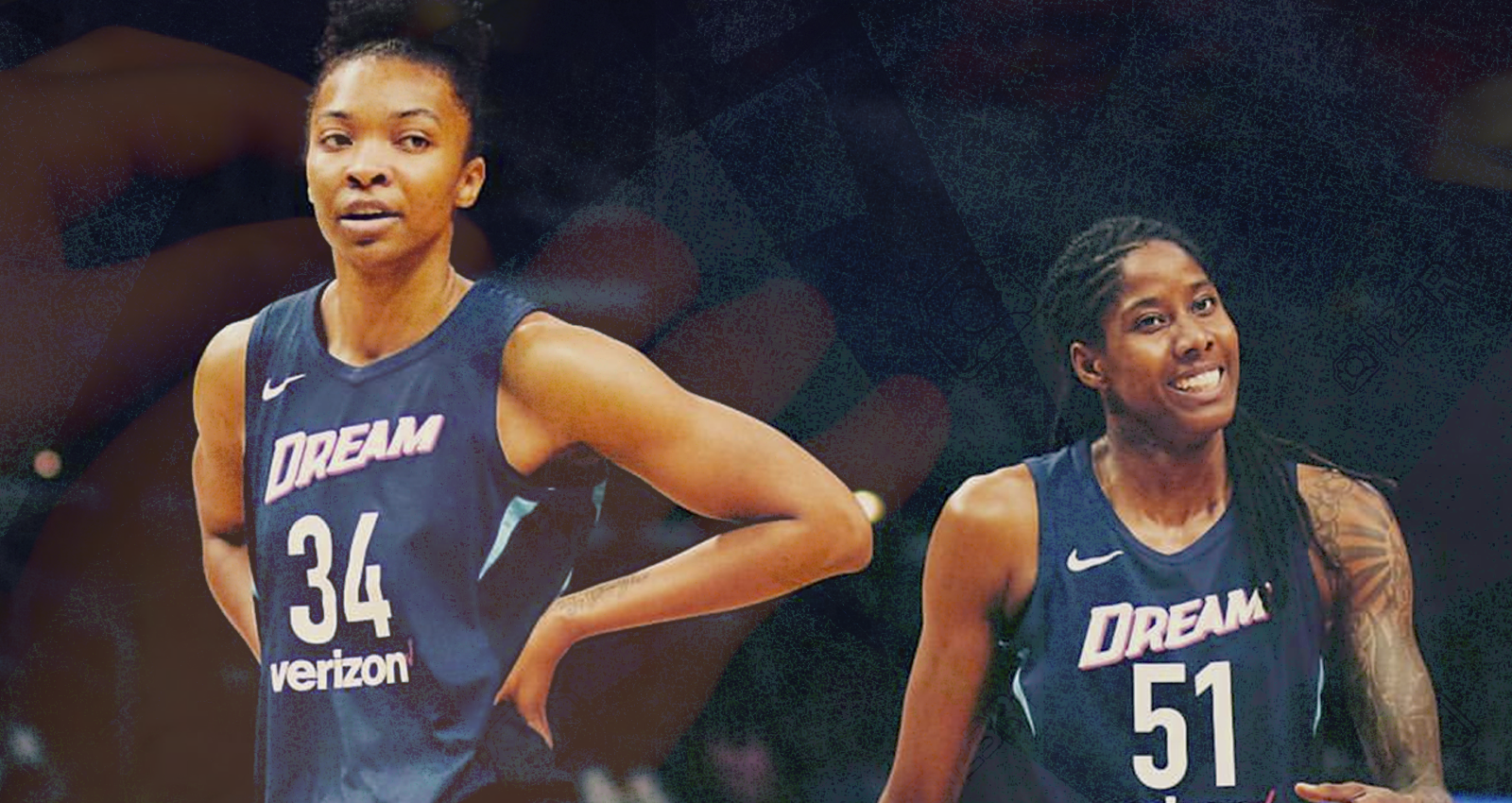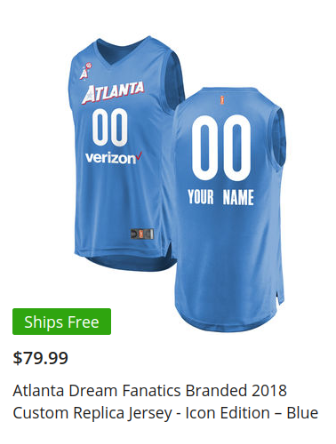Clapping Back at WNBA Trolls and Haters with Imani McGee-Stafford
Last week, we wrote about the WNBA’s wage gap, and the internet really didn’t want to hear about it. So, we’re talking about it again.

The quickest way to piss off a male sports fan — kicking off the parade of armchair philosophers and economists — is to bring up the issue of pay inequality in professional female sports.
It shouldn’t come as a surprise though. We live in an age where polarized political and social views are common.
While the false American narrative of “politics and sports shouldn’t mix” persists, the reality is quite opposite. Research shows that the more intense sports fans are, the more likely they are to adopt and support conservative ideology, which makes it easy to see why fans would be upset over the NFL players’ protest or WNBA players calling for equal pay.
“Republicans and Democrats are equally likely to follow sports closely,” say Emily Thorson of Syracuse University and Michael Serazio of Boston College. “However, sports fandom is positively associated with support for the U.S. military, as well as the conviction that individuals are largely responsible for their financial success or failure.”
According to their study, fan intensity is significantly associated with the belief that economic success is due to individual effort — the good ‘ol “pull yourself up by the bootstraps” mantra.
(Fun fact: the phrase “pull yourself up by the bootstraps” was literally coined as a sarcastic reference to the challenges of achieving significant upward financial mobility, as it is physically impossible to actually pull oneself up by your bootstraps.)
It also notes that “both professional athletes and sports announcers often deliver a straightforward narrative in which victory is solely a function of effort. This reinforces a fundamental tenet of conservative thought: that we live in a just system in which those with enough drive and talent inevitably succeed.”
With that knowledge, we were not surprised by the negative comments flooding in once we published “Yes, the WNBA’s Wage Gap is a Real Thing.” It’s an effect caused by the extremist political age we find ourselves in.
Imani McGee-Stafford of the Atlanta Dream took time out of her day to talk with us about this “divisive” issue and let us know right from the start that “yes, WNBA players deserve a 50 percent share of the WNBA’s revenue.”
As far as the reality of the gender wage, McGee-Stafford made it clear that: “Sports are not an isolated existence, instead a microcosm of the world. So, the wage gap exists here as well.
A better source for the hypocrisy of the wage gap is looking at women and men’s soccer, specifically the USWNT. They are not only better than their male counterparts, but they generate more revenue as well, yet are paid less.
Well, what about the critics who say female athletes don’t deserve to earn better wages?
“Why do you care? It always baffles me when people come out of the woodworks to protest us making more — this money doesn’t come from their pocket. It’s a direct attack on the fact that we are women, playing professional sports,” said McGee-Stafford. “No one ever has any comment when NBA players hold out to get bigger contracts or think they’re making too much.”
With contract negotiations coming up soon, McGee-Stafford mentioned the WNBA Players Association would be focused on addressing the wage gap issue, and that WNBA players do in fact have the support of NBA players.
“NBA players understand and acknowledge that we are the best women basketball players in the world and deserve to be treated and compensated as such,” she said.
And as far as the twitter beef between A’Ja Wilson and Clay Travis of Fox Sports: “It always bothers me when someone uses their very large platform to bash someone/something else especially without proper research. Clay “whatever his name is” is an ignorant troll, and considering his following, you would hope he’d use it more wisely.”
Going off that same line of thinking, we decided to respond to some of our own trolls.
Nick Apex wrote: ‘You answered your own question;
Here’s your answer: the entire WNBA made $25 million in revenue last year. The NBA made $7.4 billion.”
You then spent the rest of the articlewomansplaining about how this isn’t fair.. just childish to say the least.’
Well Nick, had you taken the time to pay attention to the numbers you would have seen that the WNBA brings in $26.5 million in ticket sales, and $25 million from the ESPN television deal. That brings it to a total of $51.5 million in 2017 — not $25.Million.
The GSC panel comments on NBA Commissioner Adam Silver’s latest idea to increase interest in the WNBA.grandstandcentral.com
As mentioned, the overall revenue total is unknown to the public. We can only base our claims on the information we know, with the knowledge that there is more money not accounted for. Something we will see once negotiations between the WNBA and Players Association begins.
As far as your clever “womansplaing” quip, which I’m sure you “thought up all on your own,” professional female athletes have the right to voice issues of fairness and act. The gender wage gap exists — that’s just fact, and one way to remedy that is through collective bargaining and public grassroots lobbying.
The Suburban Nihilist wrote: ‘The WNBA now has two options, it can either do what is right and bring up the players revenue share to 50 percent, like the NBA, or just wait until players get tired of low pay, and …
Or maybe they can decide the investment isn’t worth the negative returns and shut the whole thing down.
You are a financial illiterate who doesn’t understand how fixed costs combined with low ticket sales/minimal TV revenue will severely impact any revenue sharing model.
Exploring the hypothetical impact of a superstar athlete coming out and identifying under the LGBTQ2IA umbrella.grandstandcentral.com
Dumb article. You need to stay in your lane.’
You seem to miss the part where ticket sales are steadily increasing along with ESPN’s broadcast deal.
Also, if we are taking about worthy investments, team owners should consider a long-term strategy when it comes to their players. Better pay and benefits would keep WNBA players from having to take on extra work in international leagues — preventing player fatigue, and would allow them to completely focus their time and energy on building up the WNBA.
And if that doesn’t seem to make sense to you, go ahead and read up on Costco’s business model and why it works.
Costco is well-known for paying its employees high wages. In America, a Costco worker earns, on average, about $21 per hour and receives health benefits, ample vacation time and a 401(k) match. As illogical as it sounds, Costco’s high employee wages are part of its cost-savings plan. With employees earning a decent wage, they are more productive and less likely to quit.
Employee turnover is a huge cost of business. Between being short-staffed and the associated costs of finding and training new employees, it can cost a company between 40–150% of an employee’s annual salary to replace them. By removing some of the incentives a person would have to quit their job, Costco is able to reduce employee turnover and save money.
Just apply that business model to the WNBA, and I’m sure we would see significant improvements.
Gxorlando wrote: ‘First it is shear economics which is based on the fact that the WNBA is boring and not watched; it’s not sexism, it is about money generation of which they do very little. As an example, at Penn State the women’s gymnastic team out drew the men’s basketball team for years, because they were better and more fun to watch…after PS joined the Big Ten they had to up their B-ball program and things changed.aaaaa….’
I think you confuse fact with opinion. Your opinion is that the WNBA is boring, and I’m sure others think the opposite.
And yes, the generation of money is a determining factor. But, the question we should be asking is why is it different between the NBA and WNBA?
Whether we want to admit it or not, the institutionalization of gender inequality in sports is a business hinderance for all professional female leagues. Look at sports shops nationwide and you’ll have a hard time finding a WNBA player jersey.
Cut down on league visibility and watch profit margins fall.
Exactly why WNBA players, through their union, are partnering with brands and other business ventures as a strategy to reach consumers directly.
Troy Sampson wrote: ‘You named off a lot of great stats, and yes, revenue seems to be going up, across the board, but are you seriously trying to argue the revenue of the WNBA vs the revenue of the NBA, because it’s not even close. Yes there is a huge pay gap between WNBA and NBA players, but don’t you think it may be derived from the actual value these players drive. LeBron switches teams and an entire City’s economy shifts. Name 1 WNBA star that holds that kind of clout? WNBA players make a fraction of their NBA counterparts because of the economics. Pretty simple stuff.’
I believe you overestimate the economic impact teams and players have on cities.
Economists have shown the reason most teams (including players) don’t have much of an economic impact is that they don’t tend to promote new spending. Most people who would spend their limited entertainment budget on sports would have spent it elsewhere in a team’s absence — a restaurant, small business, local theater, where the money would stay within the local community.
“If every sports team in Chicago were to suddenly disappear, the impact on the Chicago economy would be a fraction of 1 percent,” said Temple University economist Michael Leeds. “A baseball team has about the same impact on a community as a midsize department store.”
We could keep going but I think we’ve made our point.
This isn’t about shaming people or calling anyone ignorant. It’s about highlighting our profound inability to discuss the intersections of sports and politics without personal attacks.
Ask more questions, listen, and speak less.
WNBA players have the right to demand better pay and benefits, the right to organize and collectively bargain, and the ability to use whatever platform they want to speak out against any form of injustice or inequality — just like you.

Al Neal is a sports columnist at Grandstand Central writing on politics, labor relations, and the general rabble-rousing found in professional sports. He spent a decade working in the trade union movement with various locals across the country. You can follow him on Twitter here, and on Instagram here. Words at www.peoplesworld.org

The Milwaukee Brewers' pitcher tried to blame his homophobic, racist and misogynistic tweets on youth and immaturity…grandstandcentral.com
